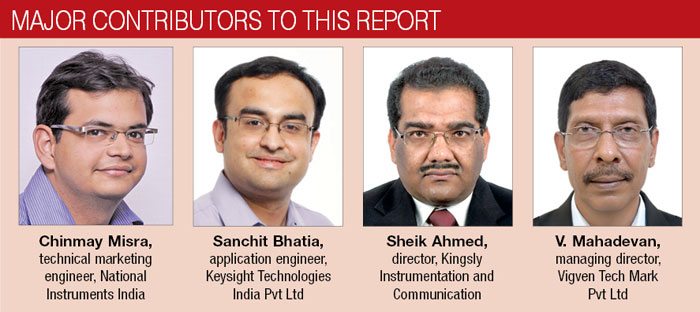Dynamic range is the ability of a digitiser to measure a smaller signal in the presence of a larger signal. In other words, it is the ratio of the maximum and minimum signal that can be measured by the digitiser at a single time, and is expressed in decibels. “A higher dynamic range allows simultaneous measurement of signals that contain both large and small voltage components,” says Chinmay Misra of NI, “and is important when measuring the overshoot, for example, when testing power supplies and multi-chop packages.”
[stextbox id=”info” caption=”Resolution and dynamic range are related by the following equation:”]Dynamic range = maximum signal value : minimum signal value = 2n : 1[/stextbox]
In normal cases, the dynamic range gets better with higher resolution. But it is to be noted that the sampling rate decreases with resolution. “It is also to be noted that using an ADC with a higher resolution does not necessarily guarantee higher dynamic range; it depends on effective number of bits (ENOB), which, in turn, depends on the quality of the hardware and the amount of noise it contributes to the measured signal,” says Sheik Ahmed.
Onboard memory. The speed of data transfer between a digitiser and PC through different communication buses is often less than the rate at which data is acquired by the digitiser. “In most applications that require single-shot/transient signal capture, the digitiser uses onboard memory to store the same,” comments Sheik Ahmed.
Once data is captured and stored in the memory, it is ready to be read out by the processor for local storage and processing. The time with which the onboard memory gets filled is given by the following equation:
[stextbox id=”info”]Buffer time = onboard memory time/(sampling rate – data transfer rate)[/stextbox]
The equation for calculating the acquisition memory required to capture a specific duration at a particular sample rate is: as follows:
[stextbox id=”info”]Acquisition memory = sample rate x time window[/stextbox]
where, time window is given as time/division×10 (10 here denotes the number of divisions on the time axis.) So, to capture 1ms of signal at 1GSa/s sample rate, we require one mega sample memory. Therefore for applications where high-speed analogue-to-digital conversions are required, the memory should also be high to avoid loss of data.

What is new
Reconfigurable digitisers use field programmable gate arrays (FPGAs) for achieving real-time decision making and high-throughput processing in measurement systems. Users can reprogram the instrument and develop custom firmware to cater to different applications without needing extensive knowledge of system design, data handling and FPGA programming. “The computational element also avoids the issue of high-speed data transfer through an external bus,” says Misra.
The author is a dancer, karaoke aficionado, and a technical correspondent at EFY.
With inputs from Spectrum Systementwicklung Microelectronic GmbH






